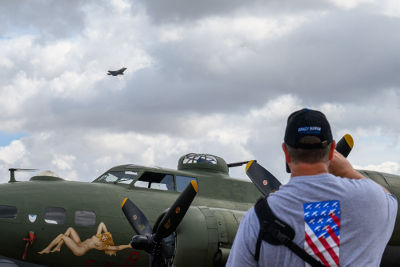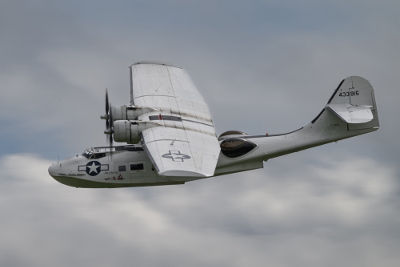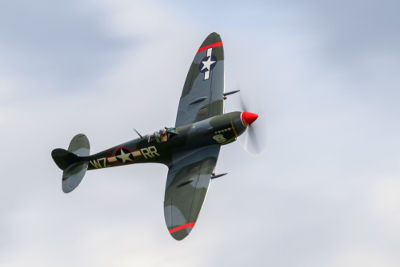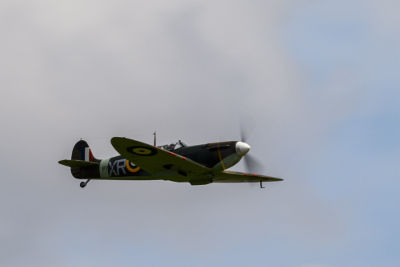 |
‘The KC-135 created
an element of jeopardy as its arrival was subject to making it to
Duxford before the main display started...’
|
The theme for the flying day on Friday, July 26th, was "The
Americans". This was one of several flying days midway through a
full season at Duxford, and holding the event on a Friday during
the school holidays helped make the venue accessible for families.
The combination of a static museum and a live airfield offers
plenty of entertainment.
A murmur of excitement was audible
on the route from the car park over the bridge as people passed
the flying display list. In addition to the advertised aircraft,
the top of the list said, "USAF opening flypast." When asked for
details, the volunteer stewards politely told visitors they would
have to wait and see. The timings promised three hours of flying
between 12:00 and 15:00, with the usual caveat of aircraft
availability; more about that later.
Arriving early at
Duxford is worthwhile to take full advantage of all the museum's
offerings and, on this occasion, to soak up some American-themed
atmosphere. The outdoor catering is fine, but the Armoury Cafe
offers an excellent full English breakfast. |
 |
 |
The American Air Museum naturally formed the focal point for the
American theme, with US Air Force engagement teams setting up
along the front with several stalls and reenactment groups. The
Lockheed SR-71 Blackbird was being celebrated inside the museum,
with a display showcasing the history of this remarkable aircraft.
Although they soon regretted setting up their stand directly in
front of the glass frontage, Duxford was enjoying a gloriously
sunny morning.
The B17 Sally-B always draws a crowd,
especially on an American-themed day. Shortly before the flying
display started, two jeeps with a full complement of reenactors
simulated an aircrew dash from the American Air Museum, which
proved very popular.
The commentary team announced that the
promised US Air Force Flypast was going to consist of a four-ship
formation of two F15Es Strike Eagles from 492/494 Fighter Squadron
and two F-35 Lighting II from 495 Fighter Squadron, all from RAF
Lakenheath, along with a KC-135. The KC-135 created an element of
jeopardy as its arrival was subject to making it to Duxford before
the main display started at 13:15.
So, precisely on time at
12:00, the F15E and F35A flew past in a tight formation before
breaking, with each of the four aircraft making low passes along
the flightline. Unfortunately, due to a late return from an
earlier operational commitment, the KC-135 couldn't make it in
time. Nevertheless, it's a testament to the close connection
between Duxford and the current-day US Air Force that they were
willing to provide operational aircraft for the flypast. The F15E
and F35A were undoubtedly appreciated by the Duxford visitors. |
 |
 |
|
|
 |
 |
| Just after 1 p.m.,
the Boeing B-17G Flying Fortress was taxied onto the runway, and
with the P47 Thunderbolt making a low pass over the airfield,
"Sally B" took off and got the main display underway. The bomber
and fighter escort then gave a joint display that symbolised the
close wartime relationship between these aircraft. The pair
carried out several passes in close formation before separating to
give individual demonstrations. |
 |
 |
Moving from Bomber and fighter escort, the T-6 Harvard (or Texan)
was next up. The Texan, flown by Isobelle Rutland, was generally
regarded as a very effective trainer for front-line pilots during
and after the Second World War. Its distinctive Pratt & Whitney
radial engine hinted at what would come later in the show.
The commentary at Duxford is worth mentioning. Some venues
struggle with sound quality on the PA. Aside from being very
clearly audible, Ben Dunnell provides enough information to add
some interesting backstory to the aircraft while not getting in
the way of the display. As well as some interesting interviews
before the display commences. |
 |
 |
The Catalina Flying Boat was to be displayed after the T-6
Harvard, but between the displays, the audience was treated to a
mass take-off consisting of the Piper Cub, Cesna 170B, A2 Air
Coupe and L4 from the tarmac and grass runways, closely followed
by the Tiger Moth and Boeing Stearman 75. Clearing away
immediately, they left the display area to the Catalina.
Like many of the resident aircraft at Duxford, the Catalina has a
wonderful history; flown by John Harmsworth, it gracefully
demonstrated configurations with the floats deployed and
retracted. The Catalina at Duxford is the UK's only airworthy
example; carrying the name "Miss Pick Up", she features the
markings of the 5th Emergency Rescue Squadron of the 8th Air
Force. It would be easy to imagine that the bulging glass windows
on the sides of the airframe were to help with search and rescue.
They were, however, fitted when the Catalina was being prepared
for wildlife spotting in Africa.
Before the Catalina
display, John Harmsworth recounted an extraordinary trip to Wick
as part of a five-day flight around former RAF Coastal Command
stations. This included a visit to Flt Lt John Cruickshank, a
wartime Catalina pilot awarded a VC for his bravery flying a
Catalina of 210 Squadron out of Sullom Voe in Shetland in July
1944. |
 |
 |
The theme for the next part of the display was trainers. The de
Havilland's Tiger Moth DE-745 visited Duxford from its base at
Audley End. It may not seem obvious, but when the US Air Force
arrived in the UK, they were short of training aircraft, so the
RAF made a number of Tiger Moths available. The Tiger Moths Kept
their original colour scheme, with the RAF roundels replaced with
the US Air Force Star. The rest of the "Trainers" were the Cesna
170b, Piper Super Cub, L4 Grasshopper, ERCO Ercoupe and
Boeing-Stearman Model 75. This part of the display finished with
four aircraft performing a break along the B axis, which was an
unusual but fun manoeuvre for slow-moving aircraft.
The
Lockheed 12 Electra, Grumman Wildcat, PA50 Hawk 75 and Curtis P-36
were next to take off in quick succession. In addition to the
overarching American theme, some thought had gone into the
combinations of display aircraft. The theme for this part of the
display was "The Radial Formation." The Radial engine is a
distinctive sound at any Duxford show, and it was novel to see
these four together. |
 |
 |
|
|
 |
 |
|
The four aircraft flew up and down the flightline in a tight
formation, providing an excellent opportunity for
photographers. The Grumman Wildcat then displayed solo,
demonstrating its power and manoeuvrability. This was followed
by a joint display with the Curtis P-36C Hawk and Hawk 75 of
The Fighter Collection, based at Duxford.
The final
item on the display was a pair of Spitfires: the Supermarine
Spitfire Mk1a from Comanche Fighters and the Supermarine
Spitfire Mk16e, aka "The Suffolk Spitfire". The Mk16 was
painted in the US Air Force colours, keeping to the day's
theme. George Haye was at the controls of the "Suffolk
Spitfire" with Ann Walker flying the Mk1a.
After
displaying as a pair, the MK16 gave a lively solo display,
again giving the photographers packed along the crowdline
plenty of top-side views.
|
 |
 |
|
|
 |
 |
The Spitfires closed the
show, ending just over two hours of flying spread over the
afternoon. With most ground exhibits and museum buildings staying
open well after the flying finished, there's no reason to rush out
of the venue. In fact, it's worth holding back to let the traffic
disperse.
The next event at IWM Duxford is the Battle of
Britain Air Show weekend on September 14th and 15th. Hopefully,
The BBMF Lancaster will be able to resume its display schedule and
join the B-17G for the promised formation display. |
|
|
|
Review by Chris Clarke
|
|
